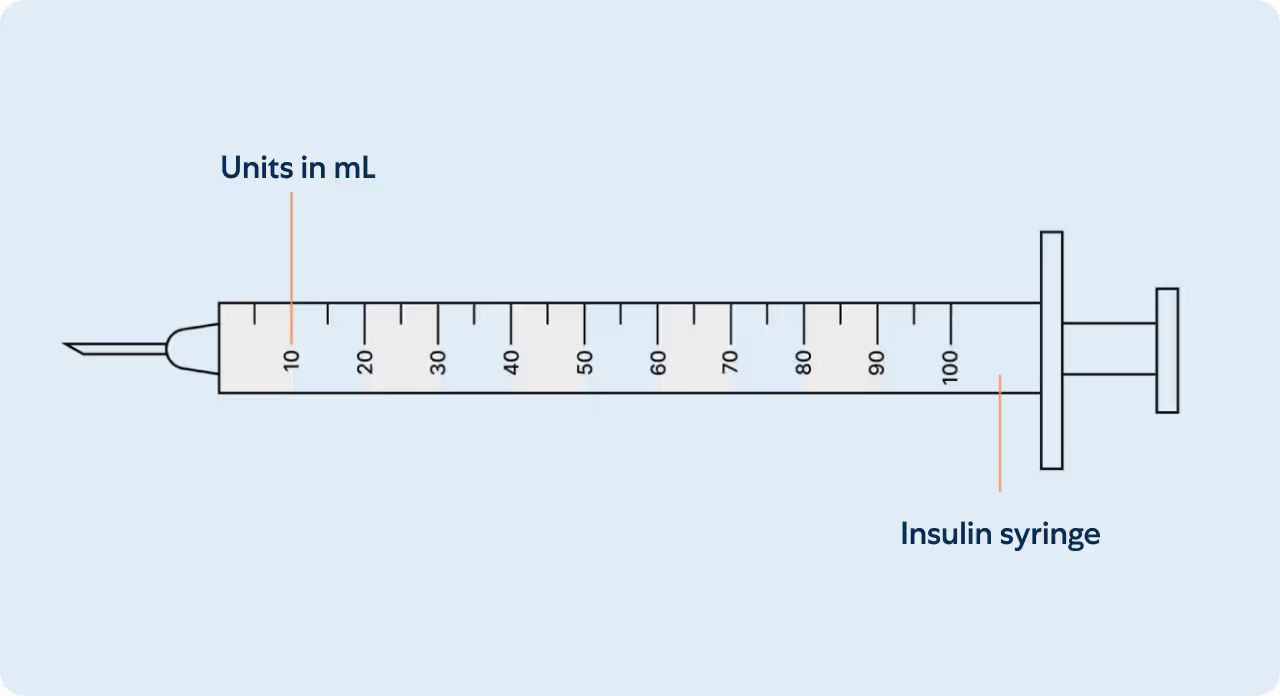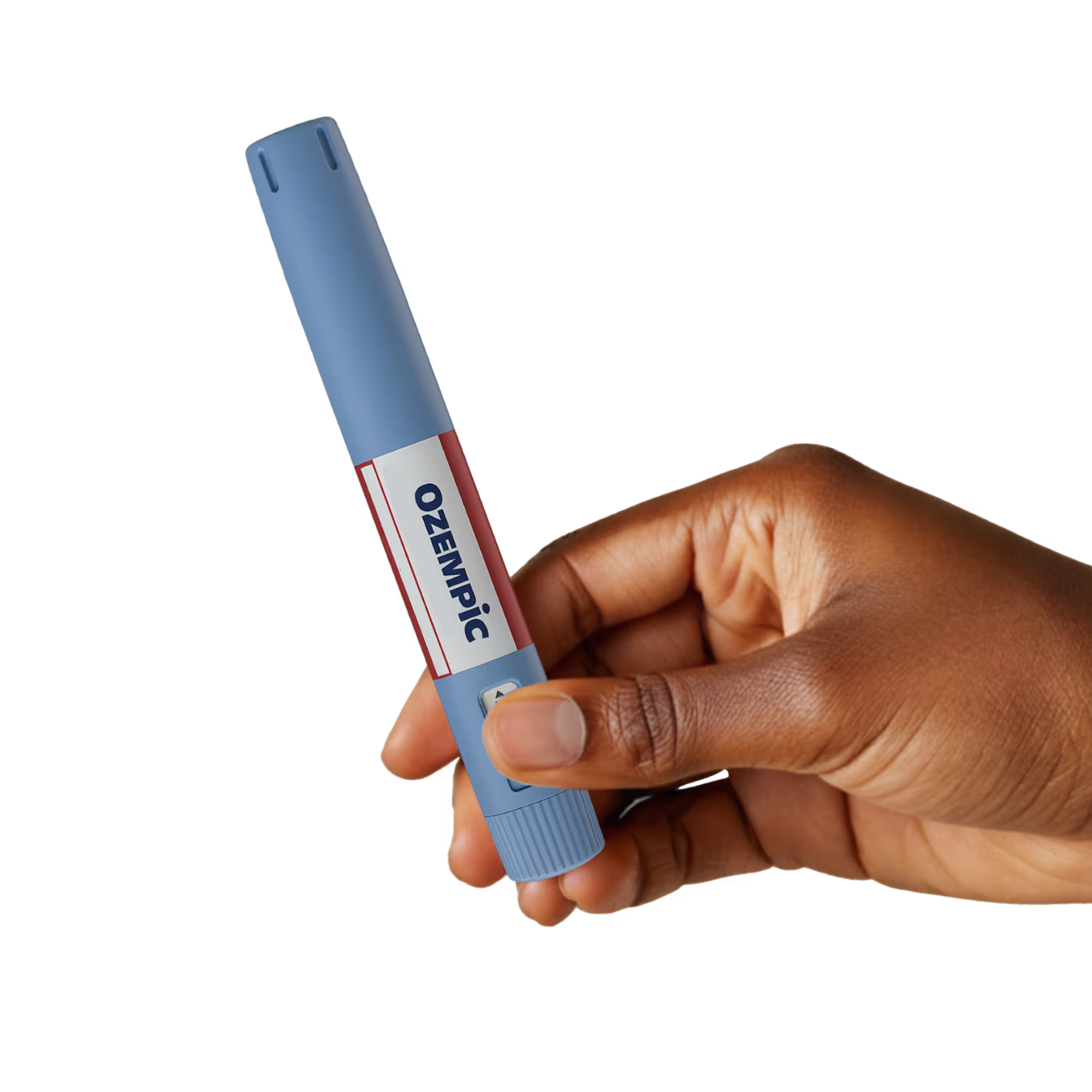Storage
Store unopened Ozempic pens in the fridge at 36–46 °F (2–8 °C). Do not freeze. After the first use, you can refrigerate or store at room temperature (59–86 °F / 15–30 °C) for up to 56 days, then discard. Protect from heat and light. For more information, visit Ozempic’s official site.
Instructions
This information is intended for individuals who have been prescribed Ozempic by their Alan Health provider.
For instructions on how to administer this medication, please visit the manufacturer’s website: Ozempic website
Understanding your insulin syringe

Measuring your dose
Insulin syringes are used for subcutaneous injections. They are marked in Units on the insulin syringe barrel (see illustration). Insulin syringes facilitate the precise measurement of tiny amounts of liquids which are ideal for medications such as insulin that require small and accurate dosing. Unit marks are also expressed in mL’s and can be interchangeably referenced. A prescriber may write a prescription in Units or in mL’s.
Within the amount of liquid is the prescribed mg dosage of your medication (see mg chart). Milligrams (mg) is not an amount of liquid, but rather the amount of drug that is within. The conversion between units and milligrams varies depending on the concentration of the product being used.
What can I expect?
Safety information
The most common side effects of OZEMPIC® (semaglutide) include nausea, diarrhea, and vomiting.
Other commonly reported side effects may include constipation, abdominal pain, headache, fatigue, indigestion, dizziness, bloating, belching, low blood sugar (particularly in patients with type 2 diabetes), flatulence, gastroenteritis, acid reflux, and nasopharyngitis. If these symptoms persist or worsen, stop taking the medication and contact your healthcare provider.
A full list of side effects can be found here.
Indications
OZEMPIC® is a prescription GLP-1 receptor agonist indicated:
- As an adjunct to diet and exercise to improve blood sugar (glycemic) control in adults with type 2 diabetes mellitus.
BLACK BOX WARNING: Risk of Thyroid C-Cell Tumors
In animal studies, semaglutide caused thyroid C-cell tumors, including medullary thyroid carcinoma (MTC). It is unknown if this risk applies to humans.
Do not use OZEMPIC® if you:
- Have a personal or family history of MTC or Multiple Endocrine Neoplasia syndrome type 2 (MEN 2).
Are pregnant, planning to become pregnant, or breastfeeding without medical consultation.
Contraindications
Do not use OZEMPIC® if you:
- Have a personal or family history of MTC or MEN 2.
- Have type 1 diabetes.
- Have a history of pancreatitis.
- Have severe gastrointestinal disease (e.g., gastroparesis or difficulty digesting food).
- Have a known allergy to semaglutide, any GLP-1 receptor agonist, or any inactive ingredient in OZEMPIC® (e.g., di-sodium phosphate dihydrate, propylene glycol, phenol, water for injection).
- Have a history of suicidal behavior or current suicidal ideation.
Warnings and Precautions
- Pancreatitis: Acute pancreatitis has occurred in trials. Discontinue immediately if suspected. Do not restart if confirmed.
- Gallbladder Disease: Cases of cholelithiasis and cholecystitis have been reported. Monitor for symptoms such as abdominal pain or gallstones.
- Kidney Injury: Acute kidney injury has been reported, especially in patients experiencing severe gastrointestinal side effects. Monitor renal function in at-risk patients.
- Hypoglycemia: Use with insulin or insulin secretagogues increases risk of low blood sugar, including severe hypoglycemia. Dose adjustments may be necessary. Educate patients about signs and symptoms of hypoglycemia.
- Diabetic Retinopathy: Complications have been reported. Patients with a history of diabetic retinopathy should be monitored closely.
- Heart Rate Increase: Monitor heart rate regularly; increases have been observed.
- Suicidal Thoughts and Behavior: Monitor for new or worsening depression or suicidal ideation. Discontinue if symptoms develop.
- Hypersensitivity Reactions: Postmarketing reports include anaphylaxis and angioedema. Discontinue immediately if hypersensitivity is suspected.
Drug Interactions and Limitations of Use
- OZEMPIC® delays gastric emptying and may affect the absorption of oral medications. Use with caution when co-administering drugs that require rapid gastrointestinal absorption.
- Do not use OZEMPIC® in combination with other semaglutide-containing products or other GLP-1 receptor agonists.
- OZEMPIC® is not indicated for the treatment of type 1 diabetes mellitus.
- Clinical studies have not established the safety of OZEMPIC® in patients with a history of pancreatitis.
Reproductive Considerations
- Pregnancy: May cause fetal harm. Discontinue OZEMPIC® immediately if pregnancy is recognized.
Reproductive Planning: Stop OZEMPIC® at least 2 months before a planned pregnancy due to its long half-life. - Breastfeeding: Avoid use while breastfeeding unless approved by a healthcare provider.
To Report Adverse Reactions, contact the FDA:
- By phone: 1-800-FDA-1088
- Online: www.fda.gov/medwatch
Disclaimer
These statements are intended for informational purposes and do not replace professional medical advice. Talk to your healthcare provider about any questions or concerns related to OZEMPIC®.
Note: The above statements have not been evaluated by the Food and Drug Administration. This product is not intended to diagnose, treat, cure, or prevent any disease.
Frequently Asked Questions
What are the side effects of Ozempic?
Potential side-effects can vary between individuals, based on medical history and lifestyle factors. The most common side effects are gastrointestinal: nausea, vomiting, diarrhea, and constipation. These often occur during dose titration and typically decrease over time. Rare but serious risks include pancreatitis and gallbladder issues.
Is Ozempic the same as Wegovy?
Ozempic and Wegovy contain the same active ingredient (semaglutide), but they are approved for different uses and come in different dosing ranges. Wegovy is FDA-approved for weight loss, while Ozempic is indicated for type 2 diabetes but is often used off-label for weight management.
How do I store Ozempic pens?
Store in the refrigerator between 36–46°F. Once in use, the pen may be stored at room temperature (up to 86°F) for up to 56 days.
Additional support
For details about your medication and dosing, please log in to your patient portal. Your physician is here to help with any medical questions. If you are experiencing a medical emergency, call 911 right away.













